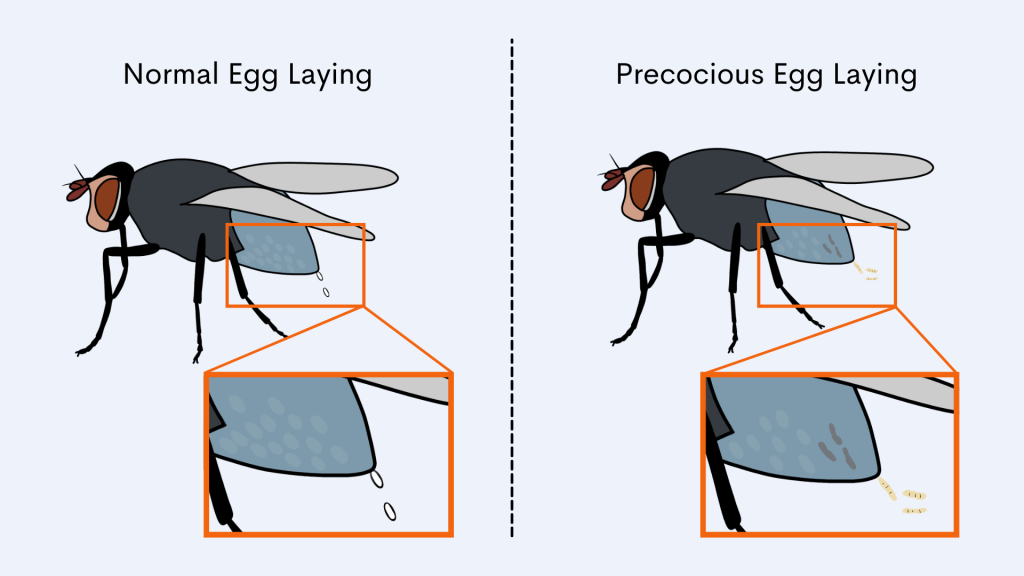Feature Photo by laurent KB from Flickr
Immediately after death, the body releases fluids and fumes that attract blowflies and other insects to a nutrition source for their offspring. Thus, our insect friends, especially the blowflies, are often the first to arrive to the crime scene and leave their mark by laying eggs and scavenging for resources. This makes insects an extremely valuable source of evidence to narrow down a window of time for when the crime could have been committed. Forensic entomologists, tasked with preserving, collecting, and interpreting insect evidence, often take the oldest (and usually largest) immature insect, called larva, and calculate the time required for it to develop to that stage (Figure 1). This calculation reflects specific temperatures, habitats, species, and other factors. However, the possibility of precocious egg development has been understudied and often overlooked when examining insect evidence.

What exactly is precocious egg development? Blowflies have the amazing ability to hold onto their fertilized eggs if an appropriate, nutritious substrate (i.e. a human cadaver or dead vertebrate), is not immediately available. They will store these eggs until they encounter a suitable substrate. However, these eggs continue to develop while stored in their mother’s body. Consequently, when the blowfly finally finds a suitable substrate, she will lay first instar larvae that have already hatched (Figure 2). This could lead to inaccurate estimations that place the time since death much earlier than reality.

Because this phenomenon is widely understudied (only two previous studies), PhD student Lena Lutz and her advisor Dr. Jens Amendt investigated the occurrence of precocious eggs in a forensically important blowfly, Calliphora vicina. They collected 5,216 females over three seasons, Spring, Summer, and Autumn, and found roughly 44% of them to be gravid, or ready to lay eggs. Out of these gravid flies, over half of them exhibited precocious egg development. This incidence was even higher in the spring, with 64% of gravid females containing precocious eggs. These results indicate a much higher probability of precocious eggs being laid on a body, yet forensic entomologists often do not consider this in their calculations.
Now that this phenomenon has been shown to be much more common than previously thought, how can forensic entomologists incorporate this factor into their calculations?
While no perfect solution exists, studying precocious egg development in other forensically important fly species would show when it should be considered in estimations. If other species do not exhibit a high occurrence of precocious egg development, it may be only be important when species like C. vicina are collected from a crime scene.
Another solution proposed by Erzinclioglu, suggests that forensic entomologists should provide estimations based on the age of the larvae that are most abundant, instead of the oldest and largest larvae. This would avoid using the oldest larvae that were laid as first instars and potentially providing a window of time earlier than when a crime was actually committed.
The authors Lutz and Amendt suggested that the most appropriate way to deal with the likelihood of precocious egg development is to focus on species that do not present this phenomenon; however, it would ultimately be most important to reassess the methods used for calculations on a case-by-case basis.
With this new finding, forensic entomologists must reexamine which factors contribute to their time since death estimations. Further research must be done to determine the impact of precocious egg development, especially across different species, when dealing with insect evidence.
| Title: | Precocious egg development in wild Calliphora vicina (Diptera: Calliphoridae)—An issue of relevance in forensic entomology? |
| Authors: | Lena Lutz and Jens Amendt |
| Journal: | Forensic Science International |
| Year: | 2019 |
| Link: | https://www.sciencedirect.com/science/article/pii/S0379073819304876?via%3Dihub |
| DOI: | https://doi.org/10.1016/j.forsciint.2019.110075 |
